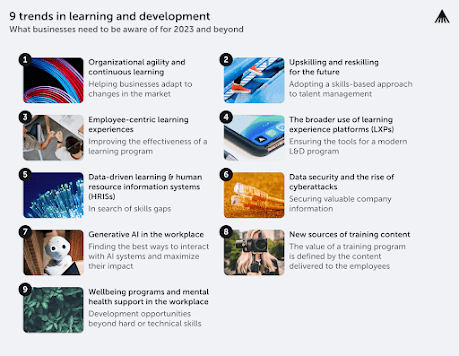07. What are the Current Trends of Training and Development?
Current Trends of Training and Development
Businesses are doing everything they can to develop a staff that is productive. The labour market of today is cutthroat. They have clear objectives and drive themselves. It also takes work on your part to redirect their energies towards productivity. Much of it is dependent upon what your business can provide for them. The main themes in corporate training and development for 2022–2023 are covered in this blog. (Snehnath Neendoor 2023 November)
1. Organizational Agility and Continuous Learning
An increasing number of companies are beginning to implement a skills-based approach to talent management. By prioritising skills above roles, this approach guarantees that workers have the state-of-the-art abilities required for success.
Additionally, companies are starting to implement best practises for product development more widely, creating project teams that prioritise job completion over following conventional departmental and business unit hierarchies.
Most employees share the same excitement for retraining and acquiring new skills. According to PWC's workforce of the future report, 74% of workers desire to continue getting new skills in order to stay employable.
Employers can improve their skill-building programmes even more by introducing incentive or recognition schemes that pay staff members for their involvement.
3. Employee-centric Learning Experiences
The success of an organization's L&D programmes as a whole depends on how well each individual employee's learning experiences work out. Businesses may improve the effectiveness of their training programmes and get closer to their goals by putting their people first and making the most of every experience.
The fundamental tenet of an employee-centric learning culture is to support individual achievement as a means of propelling organisational expansion. To maximise their learning experience, businesses can look at every employee's training lifecycle, from onboarding to departure.
LXPs provide all the resources needed to create cutting-edge L&D programmes with distinctive learning paths. Combining learning content from various sources, authoring tools to enable the production of fantastic new content, increased use of data and analytics to suggest pertinent information to each employee, and the technologies required to support modern L&D practises are all examples of this.
LXPs provide an answer to numerous issues that L&D will be confronting in 2023. It is not unexpected that companies are switching from conventional L&D technologies to LXPs and all of its advantages.
One-size-fits-all, generalised training is no longer effective. Each employee is unique, possessing a unique set of abilities, backgrounds, and specialties.
Data is the foundation of emerging technology. For modern operations, it is imperative to harness additional data and use it to improve L&D processes. But there's also a greater chance of cyberattacks because of our growing reliance on technology.
There is an increasing risk that hackers will breach business networks, hold data hostage for ransom, or make it available to the general public. IT staff were forced to quickly alter business networks in response to the pandemic, which also hastened digital transformation projects and created new virtual workflows that unintentionally increased the attack surface for cyber criminals.
By automating the generation of learning content, generative AI empowers learning and development (L&D) teams to produce realistic and contextually relevant case studies, simulations, and scenarios that captivate students and promote skill development. This enables learning and development (L&D) teams to match student demands for high-quality, personalised learning experiences while saving time and money. Through the provision of intelligent recommendations, personalised assessments, and real-time feedback, generative AI aids in the creation of interactive and adaptive learning materials.
By producing insights, promoting knowledge sharing throughout the company, and extracting and organising information from massive volumes of data, generative AI also enhances knowledge management and collaborative learning.
- Improved motivation and productivity
- Fewer absences
- Higher job satisfaction
- Better company reputation that helps the hiring process
- Higher staff retention
References
- Neendoor S. 2023 November 07, Training and Development trends to watch out for in 2023 , [Online], Available at: https://kitaboo.com/top-trends-corporate-training-and-development/ [ Accessed on 15th of November 2023]
- MacAllister R., Trends in Employee Learning and Development 2023 and Beyond, [Online], Available at: https://www.valamis.com/blog/trends-in-learning-and-development [ Accessed on 15th of November 2023]
- Olmstead L. 2023 October 31, L&D Trends to watch in 2023, [Online], Available at: https://whatfix.com/blog/learning-development-trends/ [ Accessed on 15th of November 2023]





This article by Snehnath Neendoor provides a timely and insightful overview of the evolving landscape of corporate training and development. The acknowledgment of the changing skill sets required for modern work, coupled with the emphasis on reskilling and onboarding in the face of talent shortages, reflects a keen understanding of the current challenges in the labor market. The recognition of internal development as a competitive advantage aligns well with the dynamic nature of the business world. Neendoor's focus on ongoing efforts and awareness of emerging trends adds practical value to navigating the evolving field of training and development.
ReplyDeleteThe Training and Development landscape continues to evolve, emphasizing agility, personalized learning experiences, tech advancements, and holistic employee well-being. These trends redefine how organizations empower their workforce in this era of rapid change and innovation.
ReplyDeleteAnd I like to know what's your favorite aspect of the evolving trends in Training and Development?
To what extent can individuals or organizations effectively compete and remain relevant in the face of current training and development trends?
ReplyDeleteVery informative article Dinesh. When we refer these 9 trends of learning & Development, Organizations that stay abreast of these trends are better positioned to create dynamic and effective training and development programs that meet the evolving needs of their workforce.
ReplyDeleteHi Dinesh,
ReplyDeleteVery important Article.
How can organizations effectively measure the success and impact of well-being programs and mental health support initiatives on employee performance and overall organizational success?